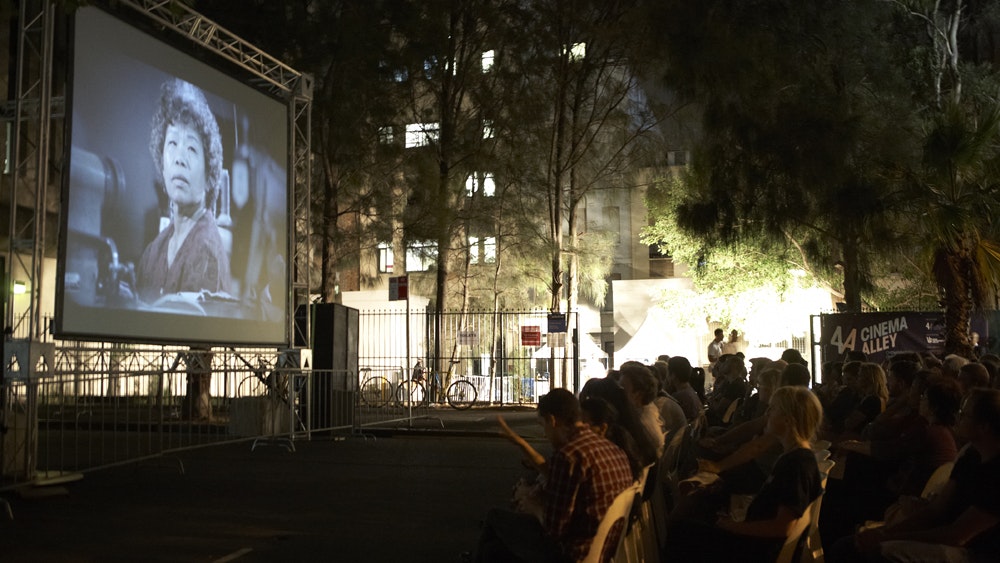CINEMA ALLEY 2011

When
Friday, 11 February 2011, 9:00am
Location
Parker Street, Haymarket
11 February 2011, 8PM
Cinema Alley is a one-night only street cinema that showcases significant video works by contemporary Asian and Australia artists. It is an annual event that takes place during City of Sydney’s Chinese New Year Festival.
In 2011, Cinema Alley’s curated program explored the ideas of the city – their transformation, experiences of alienation and the effects that history and tradition place on the individual. The selection of works include leading artists Chen Chieh-Jen, Jun Yang, Ou Ning, Cao Fei, Wang Qingsong, Yuan Goang-ming. A selection of short animation works from local artists were also presented as a preview to the main screening.
San Yuan Li (2003)
Ou Ning and Cao Fei
San Yuan Li is a self-titled film about the small suburb of San Yuan Li in Guangzhou, China, directed by Ou Ning and Cao Fei in collaboration with young artists and filmmakers from the U-theque group. The film formed part of the Canton Express exhibition curated by Hou Hanru for the Venice Biennale in 2003. San Yuan Li was once a rural suburb on the outskirts of Guangzhou; however, with the expansion of the city, the suburb now finds itself at the cutting edge of real estate development. In an attempt to preserve their way of life, the people of San Yuan Li have refused to forfeit their land, forcing urban developers to build around the suburb.
The film is a metaphorical journey through China’s rapid modernisation that explores the powerful juxtaposition between the old suburb and the modern city, capturing the essence of disappearing local culture in the face of modernisation and urban development. Shot in black and white, with no dialogue and rapidly edited scenes, the film gives the impression that modernity is an unnatural acceleration of development.
The Factory (2003)
Chen Chieh-Jen
The Factory is a film by artist and filmmaker Chen Chieh-Jen that reflects on the hardship faced by the factory workers of Taiwan. In 2003 seven years following its closure, Chen Chieh-Jen invited a group of ex-textile workers to return to the Lien Fu garment factory; a place where many members of the group had worked for over two decades.
Taiwan was once one of the world’s major manufacturing centres. However, during the 1990s many manufacturing companies in Taiwan began to move offshore in search for cheaper labour. As factories began to close, employees found themselves without work, laid-off by company owners who refused to pay retirement pensions and redundancy fees.
Many of the abandoned objects in the Lien Fu garment factory remain untouched since its closure in 1996, possessing, as Chen Chieh-Jen describes, a dual sense of time. This element of simultaneous time forms the narrative structure of The Factory. The film features women returning to work after seven years of absence, using their abandoned tools as though they had never left. As the camera scans the women at work, Chen Chieh Jen intermixes documentary footage of factory workers produced by the Taiwanese government during the 1960s. The women of the film chose not to speak. To emphasise the impact of this gesture, Chen Chieh-Jen decided to remove all sound from the film.
Floating (2000)
Yuan Goang-ming
Floating is a film by artist Yuan Goang-ming that presents the harrowing experience of a man adrift on a boat at sea. The film is an existentialist metaphor that reflects on human experience, investigating the consequences of temporal displacement, and the associated feelings of insignificance and emptiness that people encounter when confronted with a loss of orientation.
A Short Story on Forgetting and Remembering (2007)
Jun Yang
The film follows a man voicing his thoughts as he wonders the streets of Taipei at night. The film’s concept is based on implanted and collective memory (essentially, a process of brainwashing that involves the fabrication of an image or story, recited over-and-over again to the extent that one begins to believe that the image or story is an event that actually occurred) and the manipulative power this psychological condition endows on reality. The man reflects on his past experiences and life in the city, which he then uses as an analogy to explain the contemporary condition of Taipei and its historical relationship to Mainland China. A Short-Story on Forgetting and Remembering investigates how individuals and their localities are shaped through collective history and memory.
Skyscraper (2008)
Wang Qingsong.
The installation featured in the video is about 35 meters high, with a diameter of 45 meters, built by 40 workers within a month or so in Changping County, 30 miles north of Beijing. The scaffolding iron bars are painted with gold colour to make them look shiny and golden under the sunshine. This golden scaffolding signifies the glory/wonder of drastic changes in urbanisation drive. The soundtrack dubbed at the end of “Silent Night” melody together with colourful fireworks celebrating the Chinese New Year creates a very peaceful while melancholy world.
“Through this video piece, I want to analyse how dramatic social changes, in particular, in terms of skyscraper, happens in China and how it has nothing to do with humanity . This ‘Skyscraper’ is like a Greek genie that grows from a smoky ground and pops up drastically. The whole process of this scaffolding construction emulates the process of beginning to end construction of a potential building.”
-Wang Qingsong